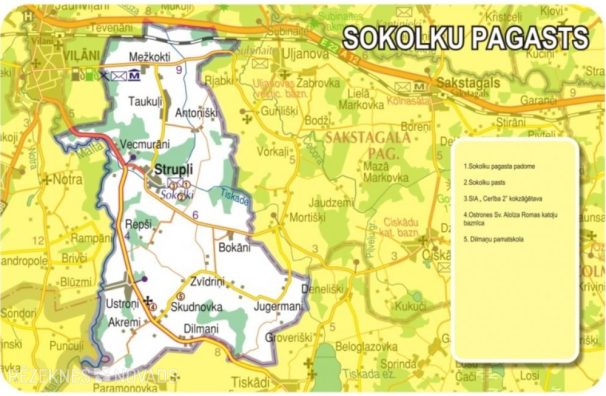Sokolku civil parish
5680 ha
Pagasta kopējā platība
14.1 ha
ūdeņi
786.0 ha
meži
4294.0 ha
l/s izmantojamā zeme
586
Iedzīvotāju skaits (uz 01.01.2025)
Sokolku parish is located in the eastern part of Vilnius. It starts immediately behind the city of Vilnius and stretches along the right coast of the Maltese River almost to the Tisky Lake. Sokolku parish borders the city of Vilnius, the municipality of Rezekne, and the parish of Silmalas, as well as the municipality of Riebiņš.
Three rivers are flowing through the Sokolku parish area: Malta, Tiskade and broke. Parish crosses the railway line Riga - Moscow and local roads: Vilnius - Books - Rezekne, Vilnius - Rwanda - Malta. From the centre of the Sokolku parish centre to the nearest city, Vilnius is 5 km, until Rezekne 27 km along the gravel road and 45 km along the asphalt road until Preiļi - 41 km and up to Riga - 220 km.
Natural resources: The Sokolku parish contains small peat, sand and gravel resources. The local population in the swamps had once prepared peat briquettes for heating, because the forest resources were small in the surrounding area. In the vicinity of Vilnius, parish in the south-west, there are wide, flat fields. During World War Ii there was an airfield that was later used for agricultural aviation. A more mountainous side of the lake is becoming more mountainous. The painting is the vicinity of the Maltese River. Although Sokolku parish cannot be proud of a large landscape and natural diversity, it maintains a relatively intact and unpolluted environment suitable for recreational and tourism.
Villages: There are 22 villages in the Sokolku parish. The largest of them are Snape, Ustroņi, Forestry, Skudnova, Flows. The specificity of Sokolku is that they had been designated by Russian Old Believers as a place of settlement 300 years ago, saving from the barrier of the cara. Around Gurilisc, Ulyanov, Paramonovka's Old Believers' prayers were made by Russians: Antoņiški, Jugerman, Skudnovka, Zavaruyevka, Podlisovka. Today, Latvians are also predominantly Russian. According to the national composition, Sokolku parish has 74% Russian and only 23% Latvian nationality.
Agriculture: Historically, in the territory of Sokolku parish, the main source of livelihoods and profits was agricultural production. As the oldest source that certifies this is the Latvian People's Say “Fairy liar and Snape pamelis”, which describes the adventures of the two Sokolku parish, the Snape and the Lower Farmers. Documents to be found in archives also indicate agricultural activity in rural territory. In October 1908, the province of Vitebsk province in Vilnius parish has existed in the Sokolku Agricultural Association. By 1942, two watermills were operated on the Maltese River, Zavarujevka and Truman.
During the 70-80 s, major melioration works were performed and the Sokolku parish at the Rēzekne District level grew with good agricultural crops and breeding stock. In 1987, the Sokolku parish “avangards” was harvested in cereal harvest of 42,8 cnt/ha, with a profitability of 30,51 TP1T.
In 1945 – 1950, the Sokolku village Council was included in Vilnius District Vilnius parish, 1950 –1962 – Vilnius district, later in Rēzekne district, from 2009 again in Vilnius District.
The parish is a post office, a library, a People's House, a feldsher - midwives point, a sawmile “hope 2”, an agricultural cooperative society “Sokolki 2”, a rural women's association “odzina”.
As viewing objects, you can mark Ostrones Sv. Aloiza Roman Catholic Church, Muranium grave, and former Socolku Manor Park. In parish forests and marshes, berries and mushrooms are growing and they are also residence for many wild animals and birds. From Sokolku parish, there have been such significant people as the publicist Stanislav Belkowski and Cordirigente Theresia Broka. The picturesque beasts of the Maltese River have been sanctioned in the poetry of Vecmurans, later BY Professor Francis Murane, Professor of THE UNIVERSITY of Wisconsin.

